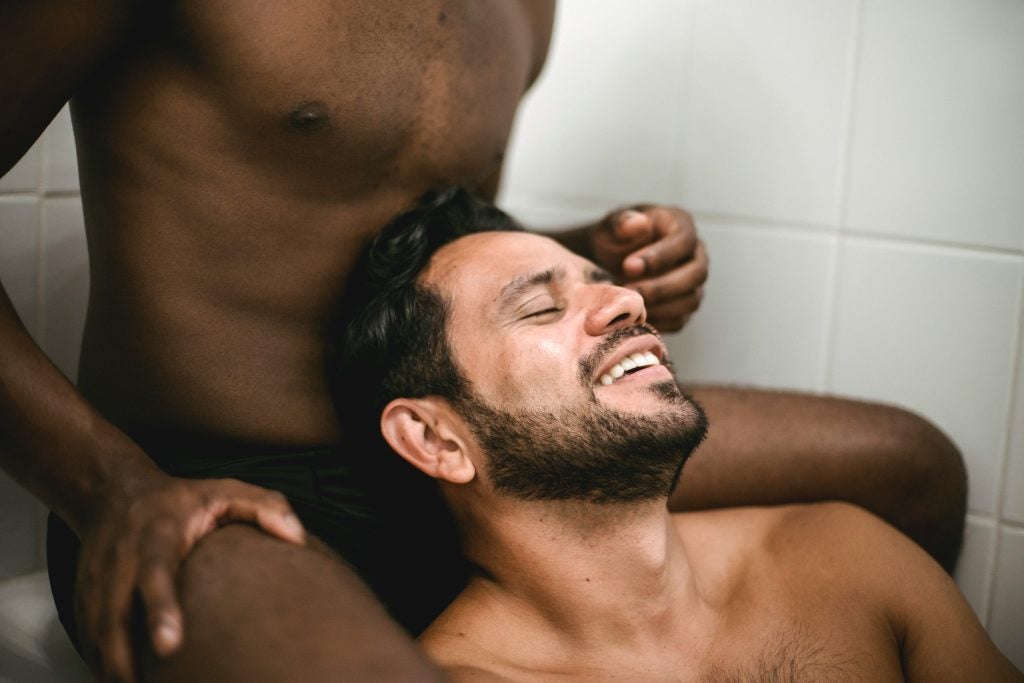Situational homosexuality is a term used to describe individual homosexual behaviors performed outside of a typical homosexual lifestyle. This article discusses situational homosexuality, its origins, and its presence in modern society.

Definition and Origin
Situational homosexuality, sometimes referred to as pseudo-homosexuality, is sexual behavior that is different from the mannerisms that person normally exhibits. This behavior is often due to a change in social environment that in some way permits, encourages, or compels this atypical behavior. Situational homosexuality may also occur when expression of a person’s typical behavior may not be possible. Situational homosexuality is not a widely used term in contemporary sociological discussions of sexuality.
The concept of situational same-sex sexual activity is not a new idea. In a written excerpt by Josiah Flynt, published in 1899, he described situational homosexual behavior among the male American hobos with whom he traveled. From the early armies of Alexander the Great to the trenches of World War I, male soldiers have found comfort in each other’s intimate company. From harems to convents to boarding schools to prisons, females who were forcibly separated from males have explored sexual relationships with each other across many centuries.4
For many, the term “situational homosexuality” is outdated, as it originated in the 1940s. The term was originally used during the late 1940s and early 1950s to distinguish between homosexual behavior performed by heterosexuals in social settings and institutions that were predominately same-sex (such as prisons, barracks, naval vessels and boarding school) and those who were actually considered to be homosexual.1 “Situational homosexuality” in the 1940s and 1950s was assumed to be temporary and primarily due to physical isolation. Situational homosexuality is prevalent among both males and females, but unlike other forms of sexual preference, situational homosexuality does not represent a fluidity in a person’s sexuality.
One reason this term is not usually heard today is that modern beliefs place sexuality on a continuum, so the term “situational homosexuality” classifies sexuality too rigidly. Sexual orientation is now understood to be fluid and non-binary (non-binary means not restricted to two fixed and rigid categories such as homosexual or heterosexual); the use of outdated terms to shield heterosexuals from the label of homosexuality may have been useful in a previously homophobic society, but currently only acts to reinforce the heteronormative attitudes of the past. Labeling people as situational homosexuals without fulling understanding the context of the situation can be misleading. This is because it makes the assumption that participants in same-sex sexual activity would not have done so were it not for their particular situation and are, therefore, not really homosexual, an assumption that should not be determined in such a casual manner. Attitudes towards homosexuality are changing with the mindset of new generations, so there are more tolerant attitudes that no longer require the shielding label of situational homosexuality.
Examples of Situational Homosexuality
Situational, or “emergency,” homosexuality often occurs when participants find themselves in a single-sex environment or in physical isolation for an extended period of time. Some single-sex environments that frequently become venues for situational homosexuality include prisons, military settings, ships at sea, convents and monasteries, athletic teams on tour, pornography and prostitution, and colleges. Situational homosexual behavior is so commonplace in these situations that many nicknames have emerged for those who participate in such interactions. The following list provides examples of a number of these slang terms: “rugger-buggers” for rugby team-members, “jailhouse turnouts” for prison inmates, and “lugs” for females in college.4 This section details common settings in which situational homosexuality is believed to be prevalent.
“Lesbian Until (College) Graduation”

The “lesbian until graduation” label is based on a common myth that college campuses are a hotspot for a considerable number of females to sexually experiment with members of the same-sex, and then identify as homosexuals upon graduating. This myth is perpetuated throughout social media and is a common theme in movies and TV shows, especially in Western cultures.5 Despite the perception that college students more readily recognize sexual fluidity and have more liberal attitudes toward sex, a 2011 Centers for Disease Control and Prevention (CDC) study suggests that this perception is misguided. Based on data from 13,500 respondents during 2006 to 2008, the study found that 5% more females with no high school diploma reported experiencing a “same-sex experience,” compared to the female respondents with a bachelor’s degree (15% compared to 10%). Six percent of the college-educated respondents reported having had oral sex with another female, compared to the 13% who had only a high school diploma. Additionally, although 13% of the female respondents overall reported participating in a same-sex experience, only 1% identified as “gay” and 4% as “bisexual,” suggesting a greater existence of sexual fluidity outside of the college atmosphere.7 This finding supports the idea that sexual fluidity is a more appropriate term than situational homosexuality. The term situational homosexual is a label often placed upon people as a way to delegitimize same-sex experiences and dismiss those who are questioning and exploring their sexual identity. One should never assume or imply that a college female’s homosexual identity is temporary or due to a desire to avoid pregnancy, ward off male attention, or evade “true” relationships so that she can focus on her studies. It is also a common mistake to assume that a college female’s homosexual behavior is an attempt to gain male attention, shock relatives, or cultivate a counterculture or progressive image.
Inmates in Prison
Situational homosexuality is most commonly understood to be a result of individuals engaging in homosexual behavior to experience sexual fulfillment in an environment in which they are deprived of heterosexual partners.1 The prison system is commonly believed to be an environment where situational homosexuality is practiced as a means of sexual fulfillment, or as an assertion of power or status over another individual. These sexual interactions often take the form of rape.2 One framework currently being used to understand the frequency of homosexual behavior in the prison system is the social constructionist approach.
Some researchers have concluded that in a setting where homosexual behavior is more socially acceptable, individuals who identify as heterosexual are more willing to engage in homosexual interactions. This theory is known as the social constructionist approach and it aims to evaluate and understand the motives behind situational homosexuality. Many inmates believe that their decision to participate in homosexual behavior does not reflect their orientation because they can convince themselves and others that they are still heterosexual, and only engaging in such behavior because they are deprived of any opposite-sex partners.1
Males in Prison: A 2013 study found that male inmates who once identified as heterosexual were 52 times more likely to change their sexual orientation after engaging in homosexual behavior.1 Conversely, even the most extreme forms of deprivation do not motivate other heterosexual males to engage in homosexual activity. Similarly, many homosexual males who are repressing their sexuality will still refuse to engage in heterosexual behavior for their entire lives. This phenomenon gives credibility to the understanding of sexual orientation on a continuum rather than being binary.3 This study concluded that those who ultimately refuse same-sex partners, even in situations of extreme isolation, are likely situated on one of the far ends of the continuum compared to those self-identified heterosexual inmates who choose to engage in homosexual behavior.1 Therefore, the social constructionist approach explains why viewing situational homosexuality through this lens allows inmates to feel more comfortable exploring same-sex behaviors and contributes to the expression and/or adoption of a homosexual identity.
Females in Prison: In a survey conducted in 2001 of 245 female inmates, researchers Koscheski and Hensley noted that prior to incarceration, only 8% of the respondents reported being lesbian, 28% reported being bisexual, and 64% identified themselves as exclusively heterosexual. While in prison, however, 13% of these females reported being homosexual, 31% reported being bisexual, and only 55% identified themselves as exclusively heterosexual.6 The researchers also found that past homosexual behavior was the most significant predictor of same-sex conduct during imprisonment, supporting the idea of sexual fluidity.
In another study conducted in 2004, 40 female offenders were interviewed and results showed homosexual relationships stemmed from loneliness and curiosity. Many of these situational homosexuals found their sexual relationships puzzling, and were concerned and anxious about “coming out” to others as well as the impact that their homosexuality might have on their personal lives upon release.6 The investigator noted that these circumstances underscored the need for programs and services that more effectively prepared females to deal with such correctional life stressors.
Actors in Gay Pornography

Situational homosexuality is represented across multiple media platforms and is most commonly featured in film, in television, and, notably, in the pornography industry. Though most studies on situational homosexuality in the pornography industry examine gay pornography, all sexual performances in the porn industry are examples of situational sexuality. The actors are often paid to engage in sexual acts for monetary compensation that they would not otherwise choose to perform and to interact with partners whom they do not necessarily feel desire for.
In the early productions of gay pornography, directors found it difficult to recruit actors because homosexual behavior was highly stigmatized. Actors were often the filmmaker’s friends, sexual partners, and boyfriends. Regardless of personal preferences, a male seeking employment in gay pornographic video production must reconcile his decisions from a number of perspectives. Participation in gay pornography can be a socially stigmatizing activity (especially for those who do not identify as gay). This criticism occurs not only because it is a form of sex work or because many people it believe negatively affects those who participate in it, but also because in many places, homosexuality is still a stigmatized form of sexuality. For a straight actor in gay pornography, performing in a homosexual production does not alter his sexual orientation or preference. Many heterosexual actors claim that their first sexual encounter with another male was on the set of a gay porn video. Since performing in pornography is an occupation for the actors, their sexual conduct is a specific response to their customers’ preferences and does not always represent their preferred sexual orientation. In other words, the customer is willing to pay for the sexual act being performed by this actor.
While some individuals may engage in homosexual behavior with an undesired partner or in an act that does not represent their preferences, situational homosexuality is a somewhat rigid label to define this type of sexual behavior and it does not align with current ideas about sexuality as a spectrum.
Conclusion
The scientific community has largely abandoned use of the term “situational homosexuality” for many reasons. It is, for the most part, outdated and inaccurate, and simply a reflection of ideological beliefs of the past. Choosing to consent to homosexual behavior does not require a term that allows an individual to maintain his or her claim to a heterosexual orientation because we now understand that sexuality is on a spectrum. Instead, situational homosexuality has typically lingered as a defense for those who choose to engage in homosexual acts yet wish to protect themselves from a potentially socially harmful label. Whether it is done for money, curiosity, or lack of available partners of the opposite sex, one’s choice to engage in homosexual behavior is not a reflection of that individual’s past or future orientation. As long as one understands that sexuality is neither fixed nor binary, and is instead fluid and non-binary, then it becomes clear why a term such as “situational homosexuality” is unnecessary and inaccurate.
References
1. Barry, Adam. “Situational Homosexuality.” Encyclopedia of Homosexuality. Web. 18 Oct. 2016.
2. Escoffier, Jeffrey. “Gay-For-Pay: Straight Men And The Making Of Gay Pornography.” Qualitative Sociology 26.4 (2003): 531-555. Academic Search Complete. Web. 30 Oct. 2014.
3. “Sexuality Definitions.” APA Guidelines and Documents. Web. 20 Oct. 2016
4. Gianoulis, Tina. “Situational Homosexuality.” SpringerReference (n.d.): n. pag. Glbtq. Encyclopedia. Web.
5. “Lesbian until Graduation.” LGBT Info. LGBT Project Wiki, n.d. Web. 28 Feb. 2017.
6. Murphy, Daniel. “Sex and Sexuality in Women’s Prisons: A Preliminary and Typological Investigation.” Sex and Sexuality in Women’s Prisons: A Preliminary Typological Investigation (n.d.): n. pag. NCDOCKS Institutional Repository, 2011. Web. 28 Feb. 2017.
7. “National Center for Health Statistics Dataline.” Public Health Reports (1974-) 115.2/3, Focus on Healthy Communities (2000): 290-91. CDC. Web. 28 Feb. 2017.
Last Updated: 27 February 2017.
